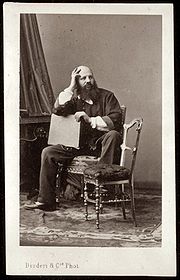
André-Adolphe-Eugène Disdéri
Encyclopedia

France
The French Republic , The French Republic , The French Republic , (commonly known as France , is a unitary semi-presidential republic in Western Europe with several overseas territories and islands located on other continents and in the Indian, Pacific, and Atlantic oceans. Metropolitan France...
photographer who started his photographic career as a daguerreotypist
Daguerreotype
The daguerreotype was the first commercially successful photographic process. The image is a direct positive made in the camera on a silvered copper plate....
but gained greater fame for patenting his version of the carte de visite
Carte de visite
The carte de visite was a type of small photograph which was patented in Paris, France by photographer André Adolphe Eugène Disdéri in 1854, although first used by Louis Dodero...
, a small photographic image which was mounted on a card. Disdéri, a brilliant showman, made this system of mass-production portraiture world famous.
Early life
Disdéri began his working life in a number of occupations, also studying art. He started as a daguerreotypistDaguerreotype
The daguerreotype was the first commercially successful photographic process. The image is a direct positive made in the camera on a silvered copper plate....
in Brest
Brest, France
Brest is a city in the Finistère department in Brittany in northwestern France. Located in a sheltered position not far from the western tip of the Breton peninsula, and the western extremity of metropolitan France, Brest is an important harbour and the second French military port after Toulon...
in 1848 or 1849 but in 1852 moved to Paris
Paris
Paris is the capital and largest city in France, situated on the river Seine, in northern France, at the heart of the Île-de-France region...
, enabling easy access to people who would be the subjects of his cartes de visite.
Disdéri and the carte de visite

Visiting card
A visiting card, also known as a calling card, is a small paper card with one's name printed on it. They first appeared in China in the 15th century, and in Europe in the 17th century...
, but Disdéri's invention of the paper carte de visite (i.e. "visiting card") photograph first enabled the mass production of photographs. On 27 November 1854 he patented the system of printing ten photographs on a single sheet (although there is no evidence that a system printing more than eight actually materialized). This was the first patent ever for a carte de visite. Disdéri's's cartes de visite were 6×9 cm, about the size of conventional (nonphotographic) visiting cards of the time, and were made by a camera with four lenses and a sliding plate
Photographic plate
Photographic plates preceded photographic film as a means of photography. A light-sensitive emulsion of silver salts was applied to a glass plate. This form of photographic material largely faded from the consumer market in the early years of the 20th century, as more convenient and less fragile...
holder; a design inspired by the stereoscopic
Stereoscopy
Stereoscopy refers to a technique for creating or enhancing the illusion of depth in an image by presenting two offset images separately to the left and right eye of the viewer. Both of these 2-D offset images are then combined in the brain to give the perception of 3-D depth...
cameras.
The novelty quickly spread throughout the world. According to a German visitor, Disdéri's studio became "really the Temple of Photography - a place unique in its luxury and elegance. Daily he sells three to four thousand francs worth of portraits".
The fact that these photos could be reproduced inexpensively and in great quantity brought about the decline of the daguerreotype and ushered in a carte de visite craze as they became enormously popular throughout Europe and the United States. So great was the publicity that all of Paris wanted portraits.
Disdéri also invented the twin-lens reflex camera
Twin-lens reflex camera
A twin-lens reflex camera is a type of camera with two objective lenses of the same focal length. One of the lenses is the photographic objective or "taking lens" , while the other is used for the viewfinder system, which is usually viewed from above at waist level...
.
The great French photographer Nadar, who was Disdéri's competitor, wrote about the new invention in his autobiographical "Quand j'étais photographe", "about the appearance of Disdéri and Carte de Visite... It spelled disaster. Either you had to succumb - that is to say, follow the trend - or resign."
Later years and death
At the pinnacle of his career, Disdéri was extremely wealthy and renowned; but like another famous photographer, Mathew BradyMathew Brady
Mathew B. Brady was one of the most celebrated 19th century American photographers, best known for his portraits of celebrities and his documentation of the American Civil War...
, he is reported to have died in near poverty.
By the end of his life, Disdéri had become penniless. He died alone and forgotten on 4 October 1889 in the Hôpital Ste. Anne in Paris, 'an institution for indigents, alcoholics, and the mentally ill'. He was a victim of his own invention. The system which he invented and popularized was so easy to imitate that photographers all over the world took advantage of it.
Sources
- McCauley, Elizabeth Anne. "Carte de visite." Oxford Companion to the Photograph, ed. Robin Lenman. Oxford: Oxford University Press, 2005. ISBN 0-19-866271-8.
- Wilder, Kelley E. "Disdéri, André-Adolphe-Eugène." Oxford Companion to the Photograph, ed. Robin Lenman. Oxford: Oxford University Press, 2005. ISBN 0-19-866271-8.
External links
- http://www.npg.org.uk/live/search/person.asp?LinkID=mp65535&role=art
- http://www.getty.edu/art/gettyguide/artMakerDetails?maker=2075
- http://www.metmuseum.org/toah/hd/infp/ho_1995.170.1.htm
- About Disdéri
- Anglo-American Name Authority File, s.v. "Disdéri, André-Adolphe-Eugène", LC Control Number n 84006003. Accessed 6 February 2006.
- Encyclopaedia Britannica, Andre-Adolphe-Eugene Disdéri. Accessed 28 November 2007.
- Union List of Artists Names, s.v. "Disdéri, André Adolphe-Eugène". Accessed 6 February 2006.
- The virtual Cabinet Card museum.
- Works by Disdéri Collection Paul Frecker, London.

